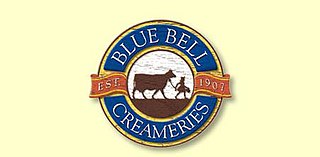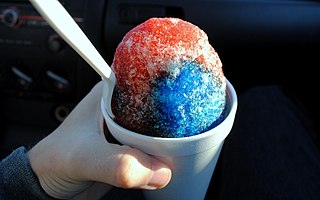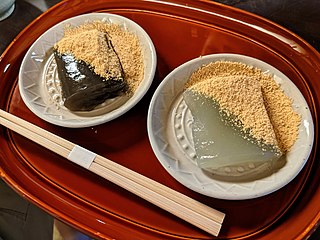Related Research Articles

Mochi, is a Japanese rice cake made of mochigome (もち米), a short-grain japonica glutinous rice, and sometimes other ingredients such as water, sugar, and cornstarch. The steamed rice is pounded into paste and molded into the desired shape. In Japan, it is traditionally made in a ceremony called mochitsuki. While eaten year-round, mochi is a traditional food for the Japanese New Year, and is commonly sold and eaten during that time.

Kakigōri (かき氷) is a Japanese shaved ice dessert flavored with syrup and a sweetener, often condensed milk.

Drumstick is the brand name, owned by Froneri, a joint venture between Nestlé and PAI Partners, for a variety of frozen dessert-filled ice cream cones sold in the United States, Australia, Canada, Malaysia, Hong Kong, and other countries. The original product was invented by I.C. Parker of the Drumstick Company of Fort Worth, Texas, in 1928.

A choc ice or ice cream bar is a frozen dessert generally consisting of a rectangular block of ice cream—typically vanilla flavour—which is thinly coated with chocolate. Related products may also include other fillings with the ice cream and be styled similar to candy bars. The term has also been used as a racial slur.

Blue Bell Creameries is an American food company that manufactures ice cream. It was founded in 1907 in Brenham, Texas. For much of its early history, the company manufactured both ice cream and butter locally. In the mid-20th century, it abandoned butter production and expanded to the entire state of Texas and soon much of the Southern United States. The company's corporate headquarters are located at the "Little Creamery" in Brenham, Texas. Since 1919, it has been in the hands of the Kruse family. As of 2015, Blue Bell was the #2 selling ice cream manufacturer in the United States.

Fruit curd is a dessert spread and topping. It is usually made with citrus fruit, though may be made with other fruits. Curds are often used as spreads and as flavorings.

Mochi ice cream is a confection made from Japanese mochi with an ice cream filling. It was invented by Japanese-American businesswoman and community activist Frances Hashimoto.

Shaved ice is a large family of ice-based desserts made of fine shavings of ice and sweet condiments or syrups. Usually, the syrup is added after the ice has been frozen and shaved—typically at the point of sale; however, flavoring can also be added before freezing. The dessert is consumed worldwide in various forms and ways. Shaved ice can also be mixed with large quantities of liquid to produce shaved ice drinks.

Shave ice or Hawaiian shave ice is an ice-based dessert made by shaving a block of ice and flavoring it with syrup and other sweet ingredients. On Hawai‘i Island, it is also referred to as "ice shave." In contrast, a snow cone, a similar American dessert, is made with crushed ice rather than shaved ice. The thin ice shavings of shave ice allow for the flavored syrups to be absorbed completely instead of sinking to the bottom. Hawaiian shave ice is derived from a similar ice-based dessert from Japan called kakigōri and thus involves similar production methods.

Kūlolo is a Hawaiian dish made with taro and coconut. Considered a pudding, kūlolo has a chewy and solid consistency like fudge or Southeast Asian dodol, with a flavor similar to caramel or Chinese nian gao. Because taro is widely cultivated on the island of Kauai, taro products such as kūlolo is often associated with the island. It is a well-beloved dish well documented by many non-Hawaiians since the late 1800s, sometimes found during festive occasions like at lūʻau.

Warabimochi is a wagashi made from warabiko and covered or dipped in kinako. Kuromitsu syrup is sometimes poured on top before serving as an added sweetener.

Frances Kazuko Hashimoto was an American businesswoman, schoolteacher, and social activist. She was a key figure and proponent of Los Angeles' Little Tokyo neighborhood. She was the head of Mikawaya confectionery company since 1970, where Hashimoto, the inventor of mochi ice cream, also introduced the dessert to American consumers.

Mikawaya is an American confectionery producer specializing in Japanese pastries, snacks, and desserts. The company's products include traditional wagashi, as well as newer offerings, such as mochi ice cream. Mochi ice cream, which was created by Mikawaya's former CEO and President Frances Hashimoto, now represents the majority of Mikawaya's annual sales.

Jeni's Splendid Ice Creams is an artisanal ice cream company headquartered in Columbus, Ohio. Jeni's has over 80 ice cream shops and retail distributors in the US.
My/Mochi Ice Cream is an American ice cream brand sold in the United States and Canada. The company was founded in 2015, after private equity firm Century Park Capital Partners bought Mikawaya, a Los Angeles–based confectionery company that is credited with the invention of mochi ice cream. To popularize mochi ice cream and make it more accessible, the company launched the My/Mo Mochi Ice Cream brand in 2017.

SomiSomi Soft Serve & Taiyaki is an American chain of independently owned and operated franchised stores based in Los Angeles, California. They primarily serve Korean Bungeo-ppang paired with soft serve, known together as ah-boong.
References
- ↑ Blufish (April 18, 2018). "Bubbies Ice Cream opens state-of-the-art manufacturing facility in Phoenix". AZ Big Media. Retrieved May 26, 2020.
- ↑ "Bubbies Homemade Ice Cream and Desserts". Inc.com. Retrieved May 27, 2020.
- ↑ "Bubbies Ice Cream opens state-of-the-art manufacturing facility in Phoenix". prnewswire.com (Press release). Retrieved May 26, 2020.
- ↑ "Bubbies Homemade Ice Cream & Desserts Inc". specialtyfood.com. Retrieved May 27, 2020.
- ↑ "About Us". Bubbies Homemade Ice Cream & Desserts. Retrieved August 16, 2015.
- ↑ GT:Glasskaka från Hawaii har blivit mat-snackis (in Swedish)
- ↑ "Ice Cream". honolulumagazine.com. Archived from the original on September 24, 2015. Retrieved August 16, 2015.
- ↑ "Mochi Madness". Hawaii Business Magazine. Archived from the original on September 6, 2015. Retrieved August 16, 2015.
- ↑ "The joy of mochi". honoluluweekly.com. Archived from the original on May 6, 2015. Retrieved August 16, 2015.
- ↑ "Why 'Mr. Bubbie' Sold His Mochi Ice Cream Empire | NOSH". NOSH. January 10, 2017. Retrieved November 18, 2018.
- ↑ "Farewell Bubbies: Hawaii Kai location set to close next month". Hawaii News Now. December 17, 2019. Archived from the original on December 17, 2019. Retrieved May 26, 2020.